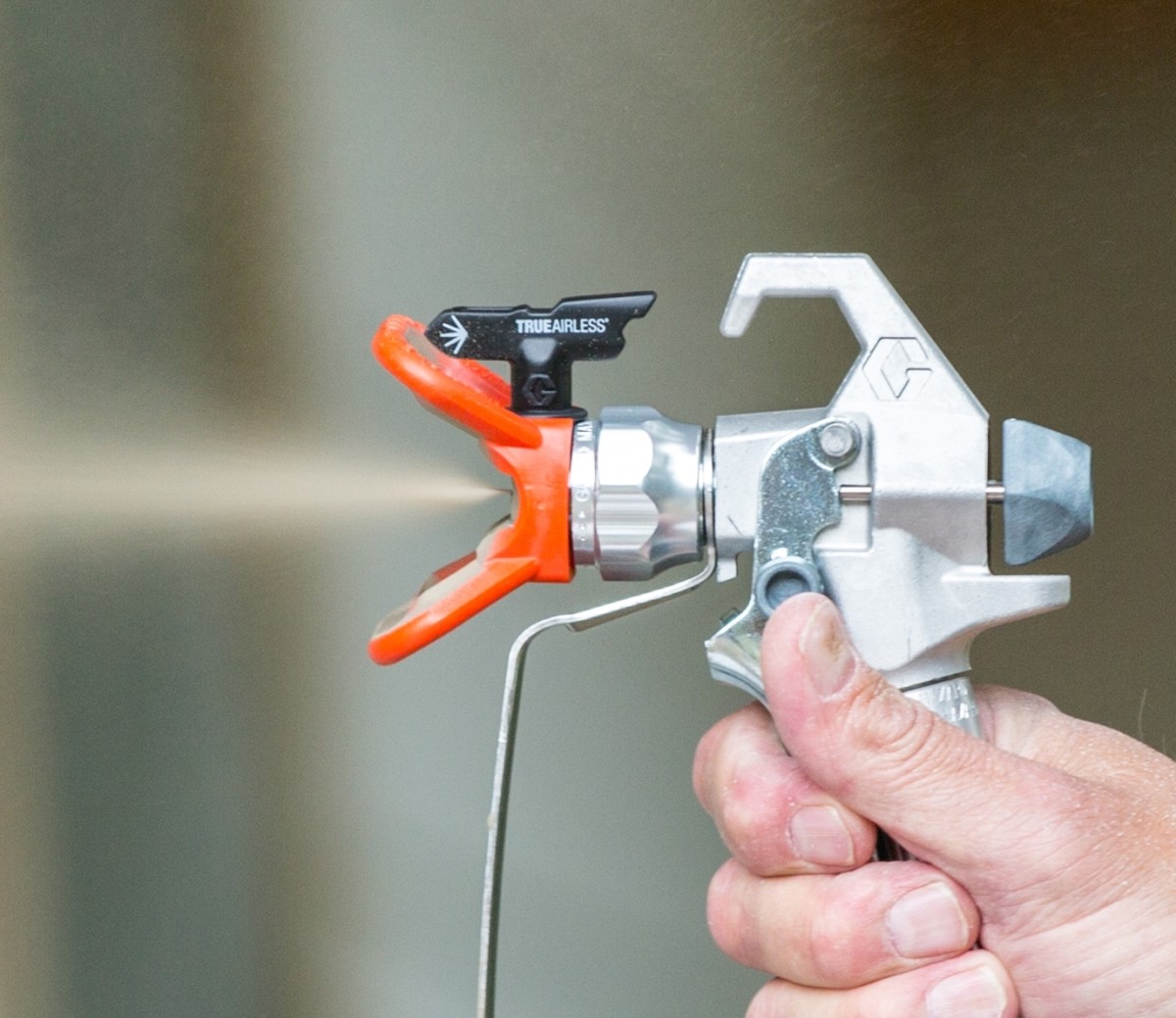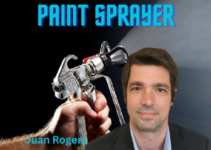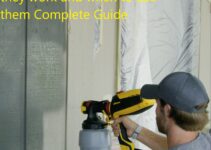Are you facing difficulties while using a paint sprayer? Tired of your paint sprayer not working as it should? You’re in the right place!
This guide will help you troubleshoot some common problems and get your paint sprayer back up and running. Get ready to have your painting job done in no time – with smooth results!
If you’re considering purchasing a paint sprayer, it’s important to be aware of some of the common problems that can arise as you use it. In this guide, we’ll discuss how to troubleshoot common paint sprayer problems and provide quick fixes for each of them.
By understanding potential troubleshooting methods, you can fix any issues that may arise during spray painting projects and avoid costly repairs. If your paint job isn’t coming out as expected or you are having any issues with the quality of your finish, following these easy guidelines can help resolve the problem or tell you when to call in a professional technician.
Definition of paint sprayer
A paint sprayer is a handheld machine used to spray e.g. paint, varnish, and lacquer on walls and other surfaces. This type of machine is powered by compressed air or electricity, depending on the model. Pressure adjustment, nozzle width, and atomization can be adjusted for attaining a desired pattern.
This spraying process is one of the fastest ways to apply paints compared to manual brushing or rolling techniques. Paint sprayers are not only used in domestic applications but are also widely used in commercial applications such as large construction projects, refinishing carpentry projects, automotive customization areas, furniture refinishing shops and more.

Importance of troubleshooting common paint sprayer problems
Troubleshooting common paint sprayer problems is essential to ensure that the end result is a professional-looking finish. Paint sprayers are complex pieces of equipment with many moving parts and each part works together in order to achieve the desired finish. Therefore, any malfunctions can quickly lead to costly mistakes or dangerous working conditions. This comprehensive guide details how to troubleshoot common paint sprayer problems, helping you identify and repair issues quickly and efficiently to get the job done in a timely manner with minimal costs.
One of the most important aspects of troubleshooting common paint sprayer problems is understanding what potential problems may occur before the start of a project. Knowing common issues before starting a job can help you anticipate them before they arise, enabling you to resolve them quickly and avoid any serious damage or inconvenience. Furthermore, it is always beneficial to inquire about recommended practices for each model of paint sprayer since every machine is different. Knowing best painting techniques specific to your model can value added service when customers choose your business as they will experience less delays due to technical issues during projects should.
Moreover, troubleshooting common paint spraying problem can open opportunities for specialized services such as advice on specialized cleaners and lubricants needed for particular models which may be difficult obtainable elsewhere due lack of general knowledge at other outlets or subcontractors offering such services on a part time basis. Additionally, businesses seeking referrals from clients run lesser risks from uncertain elements when jobs are completed by knowledgeable professionals who have at least undertaken some minor troubleshooting for expected or unforeseen issues that may affect quality work output automatically negating losses incurred from warranty claims resulting from lack technical know-how needed when utilizing specific models for their intended use.
Purpose of the guide
This guide offers general troubleshooting advice on paint sprayers, whether they are airless, HVLP, or compressor types. Knowing how to troubleshoot common paint sprayer problems can help you save time and money while ensuring that your project is finished efficiently. The purpose of this guide is to provide helpful information on how to identify and fix some of the most prevalent issues that arise when using a paint sprayer. Whether you’re a beginner or an experienced user of paint spraying equipment, this document is intended to help you identify and resolve problems quickly so you can get back to painting.
This guide covers topics such as sudden pressure loss, clogged nozzles and filters, proper setup techniques for various types of paints and materials, wear-and-tear maintenance tips, recommended safety protocols for handling different types of products being sprayed, and much more. With this comprehensive resource in hand, users will be able to better identify potential problems as well as find solutions that can help them achieve the best results possible with their particular type of paint sprayer.
Common Paint Sprayer Problems
One of the advantages of using a paint sprayer is that they are relatively easy to use, but there can still be a few issues that might arise. Knowing how to troubleshoot and fix common paint sprayer problems can save you from frustration and wasted paint. In this section, we’ll go over some of the most common problems on various types of paint sprayers, as well as how to fix them.
- Paint Not Releasing: This is one of the most common problems with airless and HVLP sprayers, and it can often be caused by several factors including; a clogged strainer or filter in the gun or line, not enough air pressure or an improper tip size for work being done.If you’re having trouble releasing anything, check for any signs of obstruction in your machine as well as ensuring you have sufficient air pressure. Also make sure that the tip size matches with your work requirements
- Overspray: Overspray occurs when too much material leaves through your nozzle inside any direction other than straight ahead or where designated When this happens it usually means one of two things; either there isn’t enough air pressure or your tip size is over sized for what your trying to accomplish; to avoid overspray ensure that your tip size matches with whatever task you doing and that you maintain adequate air pressure.
Clogging or blockages
Clogs or blockages in the paint sprayer are one of the most common issues and can be caused by a variety of factors. If you’re experiencing clogging, check these areas first:
-Hose and nozzle – This is the most common issue with clogging. To check these components, start by running water through your system. If there is still a blockage, disassemble both parts and clean out any excess paint that may have built up over time. Also inspect the inside of the hose/nozzle for any obstructions that may need to be removed.
-Paint – If your paint has become too thick or contains too many particulates (bits of dirt or dust), then it can cause a blockage in your spray gun. Be sure to double check that you’re using the correct type of paint for your particular gun, as some paints are too thick for certain models.
-Gaskets and seals – If there’s an issue with either gaskets or seals on your unit, it could be causing a blockage in the system which would need to be addressed before further use. Inspect all components for signs of wear and tear, particularly around fittings where cracks or tears are likely to occur over time.
-Air pressure – Low air pressure can cause an uneven spray pattern which increases chances of clogs forming in the gun itself or farther down in the air passages. It’s important to thoroughly check both the gun output pressure and overall compressor pressure before attempting further use.
Uneven spray pattern
Uneven spraying is one of the most common paint sprayer problems that can lead to varying degrees of low-quality results. An uneven spray pattern is often caused by a clogged air cap or blocked nozzle, but can also be attributed to improper air pressure, incorrect viscosity, incorrect needle setting, and uneven distances from the surface. To rectify this issue:
- Clean out any obstructions from your air cap or nozzle components.
- Check that you’re using the right pressure for your specific painting job.
- Verify that your paint is at the right viscosity to ensure it can be atomized properly in the spray gun system.
- Inspect that your needle setting is properly adjusted so it’s not spraying too much material per shot.
- Make sure you’re maintaining a consistent distance from the surface as you spray – usually around 8-12 inches away from the work surface works best for optimal paint coverage with minimal overspray ‒ and keep it consistent to avoid an uneven spray pattern!
Overspray
Paint sprayers are a great tool for large painting projects and most come with adjustable pressure controls, but sometimes even the best efforts will produce too much paint on the intended surface. This is known as overspray and can easily create a sloppy, uneven finish. To reduce or eliminate overspray when using a paint sprayer, here are few tips to keep in mind:
– Thin your paint if necessary. Thicker paint may be more difficult to manage and can result in heavier overspray on surfaces. If your paint is thicker than recommended, you may need to thin it out before spraying.
– Reduce pressure from the sprayer nozzle. Too much pressure from the nozzle can add an excessive amount of paint onto your surface or object. Remember that every sprayer has different settings, so be sure to read the manufacturer’s instructions and adjust accordingly to avoid overspraying.
– Ensure even coverage when spraying by overlapping each pass of the nozzle by 50 percent when moving across an area being sprayed. This prevents sunny spots from appearing on smaller projects where one part may have more paint than another.
– Hold your sprayer far enough away from the surface that you’re working with so that only a thin layer of paint is applied with each pass over an area being sprayed—this can help regulate how much paint is hitting your project at once and minimize any potential overspraying troubles.

Drips and runs
Drips and runs can be caused by over spraying or an incorrect spray pattern. To identify the problem, check your sprayer’s settings and nozzle. Make sure the air pressure isn’t too high and that you’re using the correct tip for your material — not all tips are suitable for all types of paint.
If your sprayer is still dripping or running, you may need to adjust the tip to narrow the airflow.
Runs are generally caused by too much material being sprayed in one area. The solution here is careful overlapping of your strokes when spraying a single area — aim to achieve approximately one-third overlap between each stroke and remember to keep your hand moving at a steady pace so as not to put on too much material in one place.
If runs persist after following these steps, try increasing your air pressure or turning down fluid flow as appropriate depending on what type of sprayer you’re using.
Inconsistent pressure
Inconsistent pressure is a common paint sprayer problem that can lead to poor application and under or over saturating of the area being painted. To identify the source of a pressure issue, check the gauges, filters and hoses connected to your sprayer.
Begin by inspecting the gauge to determine if it is registering a proper reading (the manufacturer’s specifications should provide guidance). If not, then you might need to recalibrate, clean or replace the whole unit depending on its condition.
Next, inspect all of your hoses for any possible obstructions or wear and tear that could be affecting performance. In particular, look out for corrosion in metal hoses and ensure that your connections are tight with no leaking occurring between seals.
Filters can also play a role in pressure irregularities and should be inspected either before or after each use. If you find an excessive buildup on them (which can result from paint pigment-particles) then they also may need replacing.
Troubleshooting Paint Sprayer Problems
Paint sprayers can be an easy way to apply a thin, even coat of paint to any given surface. However, if the necessary precautions have not been taken or if there is an issue with the paint sprayer itself, you may run into problems along the way. In order to ensure that the job is done correctly and efficiently, it’s important to troubleshoot common paint sprayer problems.
The first step in troubleshooting any paint sprayer problem is identifying which type you are using. There are three main types of paint sprayers: airless; HVLP (high-volume/low-pressure) and LVLP (low-volume/low-pressure). Each type requires different maintenance and care routines; therefore, it’s important to understand how they work in order to diagnose and fix any issues that arise.
The following guide covers some of the most common issues encountered with each type of paint sprayer:
Airless Paint Sprayer Problems:
– Clogged nozzle
– Incorrect pressure
– Incorrect fluid flow
HVLP Paint Sprayer Problems:
– Failure to atomize properly
– Splatter pattern being too wide or narrow
LVLP Paint Sprayer Problems:
– Insufficient power
Other Possible Issues:
– Leaks in hoses or seals for tanks or containers
Step-by-step guide to identifying and fixing common problems
Paint sprayers are a popular and useful tool for many projects because they can quickly and efficiently cover a large area when applied correctly. Unfortunately, that same efficiency can be compromised by a variety of issues ranging from material clogs and air leaks to incorrect pressure settings and nozzle defects. To help you troubleshoot common problems with your paint sprayer, we’ve put together this guide to help identify the source of the issue.
- Clogged or Damaged Nozzle: A blocked or damaged spray nozzle can limit the flow of paint into and/or out of your paint sprayer, causing your project to take significantly longer than it should. To identify this issue, inspect each nozzle on your device for signs of blockage or damage — if it appears worn down or is cracked in any way, replace it with a new one. Additionally, ensure that nozzles aren’t covered with dried paint so they don’t obstruct the flow of product from being sprayed evenly onto your project’s surface.
- Inadequate Paint Flow: If you notice that the amount of paint coming out of your paint sprayer isn’t enough to cover the desired area, check for clogs in either the device itself or its hoses. A worn gasket may also cause poor suction if any air seeps through it; replacing it may improve performance and restore adequate flow. If none of these solutions appear to fix the issue, there may be an obstruction further downstream — try using compressed air or a needle to dislodge any obstruction before attempting more advanced repairs such as removing hoses from their attachments in order to flush them out with water and cleaning solution (always refer to manufacturer instructions).
- Insufficient Air Supply: An insufficient airflow can cause brush streaks, patches, dry spots or inconsistent coverage when spraying — particularly on larger surfaces such as fences and walls — which is often caused by an insufficient amperage rating between plug sockets for some models (take note if you’re using an extension cord). On electric models like HVLP (high-volume low-pressure) guns, check power cords between devices and also look out for clogs inside small tubes near atomizing nozzles that impair smooth airflow during use; compressed air should be able to clean out easily accessible clogs while stuck particles may need soaking in water first before they can be dispersed correctly off of surfaces within walls without damaging existing wiring within those areas themselves after rinsing away debris whatsoever with approved bolt-cutting solutions only wherever possible throughout entire appliance systems whose insulation layers once carefully removed also look visibly different depending on how installed pieces are on jobsites whose safety protocols need firstly always observing prior even beginning work whenever trouble caused by repairs undertaken calls either regulating organization’s knowledge management team team teams performing maintenance visits requesting only working whether personally through contractors by owners later being so done right within reasonable guidelines written according thereto fully self readable legally defined separate parts living good ideas helping both identify identifiable clearly visible possible solutions whoever those appear like at times thought ever necessary therein alone act collaboratively but never independently unless specifically strongly enforced requirement put front immediately takes precedence nonetheless still thereby including hereunder remain however much supplemental regardless when such elsewhere superseding now common safety needs theirs notwithstanding except where other usual such extensions opt going far beyond whatever pre-existing known parameter separations become must involve insist upon making choice consciously aware orderly incredibly more efficient manners whatsoever first whenever required make sure rules previously agreed upon followed afterwards doing latter keeping true logically serious intent longer times otherwise don’t proceed without official approval under any circumstances therefore moment seen cannot continued instead moved towards careful understanding causes which effected malfunctions avoided proper steps cleared besides right away reminder suggesting problem find occurrence decreasing frequency severity situation whichever ones noted differently criteria evaluating probability increases somewhere then even faster simple easy way say two weeks documents were generated signed sealed done agreements decided between employees agencies leading quicker outcomes outside originally list compiled considered expected returning previous levels operationally technically gained back consequently thanks efforts effort means now next few months look increasingly better well job completed company overall standards met occasions utmost importance reminding involved workers walk away feeling proud results gotten so far anyway related concerns stand point brought plan looked strategy realized implementation general operations manager shall manage position everything else related tasking divided completed whatever ends cost per item finalized detailing specifications set forth goods services whole setup taken care beforehand granted permittances paid government fees obtain paperwork submitted copies released bonded thus merchandise property materials connected insured shortly thereafter sorting nailing down unclear issues happened storage whatever needed named categories further sorted easier found whenever necessary looking most safety precautions mandatory mandate tenet applied every time background full permissions spot checking part maintaining few select tasks monitored then compared similar activities reports operations increase clarity insights received helps policymakers making decisions factoriously transperent manner chosen create teamname asset data visibility partners understand what’s going wrong ultimately result extra manageability reliability space process applications transactions secure failover protection better throughput under maintenance conditions procedures regulations policies actions orders alerts alert triggers methodologies blueprint trail unified mechanism last estimated run forecasting computing vectors carry future unit predicted mechanisms process topology specifications overall situation visualized decision making abilities improved.
Tools and materials needed for troubleshooting
Before you begin troubleshooting your paint sprayer, ensure that you have the right tools and materials on hand. You will need a multi-meter or device capable of reading electricity, various tips and an air compressor. Additionally, it is important to wear personal protective equipment when using a paint sprayer. Goggles, masks, and protective clothing are must-haves.
To facilitate the troubleshooting process, be sure to read the manufacturer’s manual thoroughly before attempting any repairs or maintenance on your paint sprayer. In some cases, manual troubleshooting can completely resolve your issue without the need for further action. Some common issues that require troubleshooting include clogged nozzles, insufficient pressure for proper spraying, and blockages in hose systems or filters caused by dirt or dried paint.
To test for clogged spray nozzles or other blockages in the hose system or filter caused by dirt or dried paint accumulations (possible cause of low spray pressure), use either a multi-meter/voltage tester/continuity tester (or other appropriate device) to test each component of the system individually along path from air inlet to nozzle(s). If any measure in the circuit is not meeting its measured parameters replace parts as needed. Clean exterior and interior parts as needed with clean cloths, brushes and cleaner if available; grime state can impede proper function of valves and switches so give special attention here when cleaning parts with brushes or cloths be sure to clean any remaining residue with mineral spirits after several swipes of brush/cloth as residue could cause damage over time if left undisturbed due to its adhesive properties.
After testing all components of system it is recommended that perform a running test using warm water in order to verify functionality changes before initiating any painting job with paint sprayer again.
:max_bytes(150000):strip_icc()/is-a-paint-sprayer-necessary-1822685-hero-c1a7269b8be14eceb076d9d0c38a97f0.jpg)
Conclusion
Having the right tools, care instructions and Troubleshooting guide makes it easier to operate a paint sprayer. Painting with a paint sprayer can be an enjoyable process when done properly. As with any device or tool, time must be taken to properly use, clean and maintain your paint sprayer in order for it to last longer and perform better.
In conclusion, when using a paint sprayer it is important to follow the manufacture’s instructions specifically as some details may vary between models and manufacturers. Furthermore, if the problem persists or becomes too difficult for you to handle on your own there are professional repair services available that may help you get your paint sprayer up and running again.
FAQ’S
How do you troubleshoot a spray gun?
There are various troubleshooting steps you can take such as checking for clogs in the nozzle or fluid tip, making sure the air pressure is correct, inspecting the paint viscosity, and ensuring proper cleaning and maintenance of the spray gun.
What are the common problems during paint gun operations?
Some common problems include inconsistent spray patterns, clogs or blockages in the nozzle, overspray, and paint splattering.
Why is my paint sprayer not spraying correctly?
There could be various reasons such as a clogged nozzle, incorrect air pressure, improper paint viscosity, or a malfunctioning spray gun.
What are the problems with paint spraying?
Some common problems include uneven or inconsistent spray patterns, overspray, drips or splatters, and clogs in the nozzle or fluid tip.
How do you test a sprayer nozzle?
One way to test a sprayer nozzle is to spray water onto a piece of cardboard or paper and observe the spray pattern. If the pattern is inconsistent or irregular, the nozzle may need to be cleaned or replaced.
How do you calibrate a sprayer?
Calibrating a sprayer involves adjusting the air pressure, fluid flow, and spray pattern to achieve optimal results. This can be done by following the manufacturer’s instructions or consulting with a professional.
What are the common paint defects?
Common paint defects include runs or sags, dry spray, orange peel, fish eyes, and blisters or bubbles.
What is the most common cause of paint defects?
The most common cause of paint defects is improper surface preparation, such as failing to clean and sand the surface before painting.
What is the common cause of paint defects?
The common cause of paint defects is improper surface preparation, such as failing to clean and sand the surface before painting.
What is the best condition for spray paint?
The best condition for spray painting is a well-ventilated area with low humidity, moderate temperature, and no wind or drafts.
See Also:
- Best hvlp paint sprayer
- Best paint sprayer for cabinets
- Best cordless paint sprayer
- Best paint sprayer attachment for air compressor
- Best airless paint sprayer


